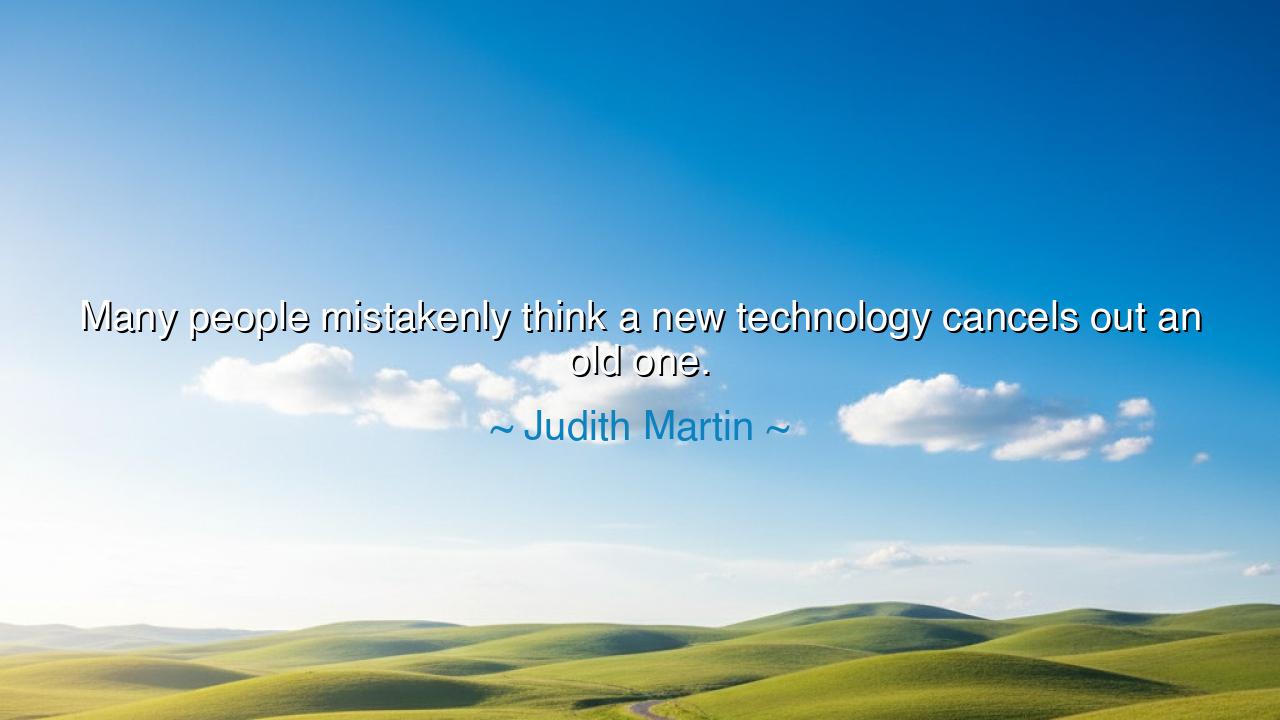
Many people mistakenly think a new technology cancels out an old






Judith Martin, the wise voice known to many as “Miss Manners,” once declared: “Many people mistakenly think a new technology cancels out an old one.” At first, her words may seem simple, yet within them lies a deep reflection on the nature of progress, memory, and the human tendency to discard too quickly what has not yet lost its worth. She warns us that the march of invention does not erase the value of what came before, but rather builds upon it, layer upon layer, like stones in the eternal temple of human culture.
The meaning is clear: when a new technology arises, people often rush to proclaim the death of the old. They declare the book obsolete at the arrival of the screen, the letter irrelevant when replaced by email, the handshake forgotten in an age of digital communication. Yet Martin reminds us that such proclamations are illusions, for the old technologies rarely vanish. Instead, they take on new roles, new meanings, and often coexist alongside the new. They may lose dominance, but they rarely lose value.
History itself gives witness to this truth. When the printing press was invented, many thought the art of the handwritten manuscript would perish. Yet to this day, calligraphy thrives, cherished as an art form, revered in holy texts, valued for the beauty of its human touch. When the radio was born, some feared the theater would die; when television arose, many proclaimed the end of cinema. And yet theater and cinema still live, reshaped but enduring, proving that each new technology expands the landscape rather than annihilating it.
Consider also the story of the sail in the age of steam. When engines first powered ships, many assumed sails would vanish into history. And yet, to this day, sailors across the seas harness the wind, whether for sport, tradition, or sustainable travel. The old and the new exist side by side, each carrying lessons that the other cannot provide. In this balance, we see the wisdom of Martin’s words: that innovation is not a battlefield where one technology destroys another, but a tapestry where each thread adds depth and variety to the whole.
Her warning is not only about objects but about patience and humility. Too often, people run to embrace the new with arrogance, dismissing the wisdom of the past. But the ancients taught that wisdom lies in discernment, in choosing when to adopt the new and when to preserve the old. A wise craftsman values both hammer and machine, a wise scholar values both oral tradition and digital archive. To discard too hastily is to sever our connection with history and to blind ourselves to the enduring worth of what has already proven its strength.
The lesson, O seekers of knowledge, is this: do not think that progress requires destruction. Rather, see each new technology as an addition, not a replacement. Cherish the old, for it carries the soul of tradition, and embrace the new, for it opens the door to possibility. Let the two walk together, as elders and youth in the same household, each lending wisdom to the other.
Therefore, remember Martin’s words when next you are tempted to cast aside what is old. Ask yourself: does it still carry value? Does it still teach, enrich, or delight? If so, let it remain, not in competition with the new, but in harmony with it. For in honoring both past and present, you weave a stronger future—one that does not forget its roots while reaching ever upward toward the skies of invention.






AAdministratorAdministrator
Welcome, honored guests. Please leave a comment, we will respond soon